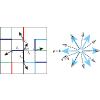当前位置:
X-MOL 学术
›
Phys. Rev. E
›
论文详情
Our official English website, www.x-mol.net, welcomes your
feedback! (Note: you will need to create a separate account there.)
Ordering kinetics in aq-state random-bond clock model: Role of vortices and interfaces
Physical Review E ( IF 2.2 ) Pub Date : 2020-03-24 , DOI: 10.1103/physreve.101.032128 Swarnajit Chatterjee , Sabyasachi Sutradhar , Sanjay Puri , Raja Paul
Physical Review E ( IF 2.2 ) Pub Date : 2020-03-24 , DOI: 10.1103/physreve.101.032128 Swarnajit Chatterjee , Sabyasachi Sutradhar , Sanjay Puri , Raja Paul

|
In this article, we present a Monte Carlo study of phase transition and coarsening dynamics in the nonconserved two-dimensional random-bond -state clock model (RBCM) deriving from a pure clock model [Chatterjee et al., Phys. Rev. E 98, 032109 (2018)]. Akin to the pure clock model, RBCM also passes through two different phases when quenched from a disordered initial configuration representing at infinite temperature. Our investigation of the equilibrium phase transition affirms that both upper () and lower () phase transition temperatures decrease with bond randomness strength . Effect of on the nonequilibrium coarsening dynamics is investigated following independent rapid quenches in the quasi-long-range ordered (QLRO, ) regime and long-range ordered (LRO, ) regime at temperature . We report that the dynamical scaling of the correlation function and structure factor is independent of and the presence of quenched disorder slows down domain coarsening. Coarsening dynamics in both LRO and QLRO regimes are further characterized by power-law growth with disorder-dependent exponents within our simulation timescales. The growth exponents in the LRO regime decrease from 0.5 in the pure case to 0.22 in the maximum disordered case, whereas the corresponding change in the QLRO regime happens from 0.45 to 0.38. We further explored the coarsening dynamics in the bond-diluted clock model and, in both the models, the effect of the disorder is more significant for the quench in the LRO regime compared to the QLRO regime.
中文翻译:

aq状态随机键时钟模型中的有序动力学:涡旋和界面的作用
在本文中,我们提出了非保守二维随机键中相变和粗化动力学的蒙特卡洛研究 状态时钟模型(RBCM)源自纯时钟模型[Chatterjee等。,物理 启ë 98,032109(2018)]。类似于纯时钟模型,当从代表无限温度的无序初始配置中淬灭后,RBCM还经历两个不同的阶段。我们对平衡相变的研究表明,)并降低()相变温度随键的无规强度降低 。的影响 在准远程有序(QLRO, )制度和远程命令(LRO, )温度条件 。我们报告说,相关函数和结构因子的动态缩放与淬灭性障碍的存在会减慢域粗化。LRO和QLRO体制中的动态不断粗化的特征还在于,在我们的模拟时间范围内,幂律的增长具有与无序相关的指数。LRO机制中的增长指数从纯情况下的0.5下降到最大无序情况下的0.22,而QLRO机制中的相应变化从0.45下降到0.38。我们进一步探索了债券稀释时钟模型中的粗化动力学,并且在两种模型中,与QLRO机制相比,对于LRO机制中的猝灭而言,无序效应的影响更为显着。
更新日期:2020-03-24
中文翻译:

aq状态随机键时钟模型中的有序动力学:涡旋和界面的作用
在本文中,我们提出了非保守二维随机键中相变和粗化动力学的蒙特卡洛研究 状态时钟模型(RBCM)源自纯时钟模型[Chatterjee等。,物理 启ë 98,032109(2018)]。类似于纯时钟模型,当从代表无限温度的无序初始配置中淬灭后,RBCM还经历两个不同的阶段。我们对平衡相变的研究表明,)并降低()相变温度随键的无规强度降低 。的影响 在准远程有序(QLRO, )制度和远程命令(LRO, )温度条件 。我们报告说,相关函数和结构因子的动态缩放与淬灭性障碍的存在会减慢域粗化。LRO和QLRO体制中的动态不断粗化的特征还在于,在我们的模拟时间范围内,幂律的增长具有与无序相关的指数。LRO机制中的增长指数从纯情况下的0.5下降到最大无序情况下的0.22,而QLRO机制中的相应变化从0.45下降到0.38。我们进一步探索了债券稀释时钟模型中的粗化动力学,并且在两种模型中,与QLRO机制相比,对于LRO机制中的猝灭而言,无序效应的影响更为显着。









































 京公网安备 11010802027423号
京公网安备 11010802027423号